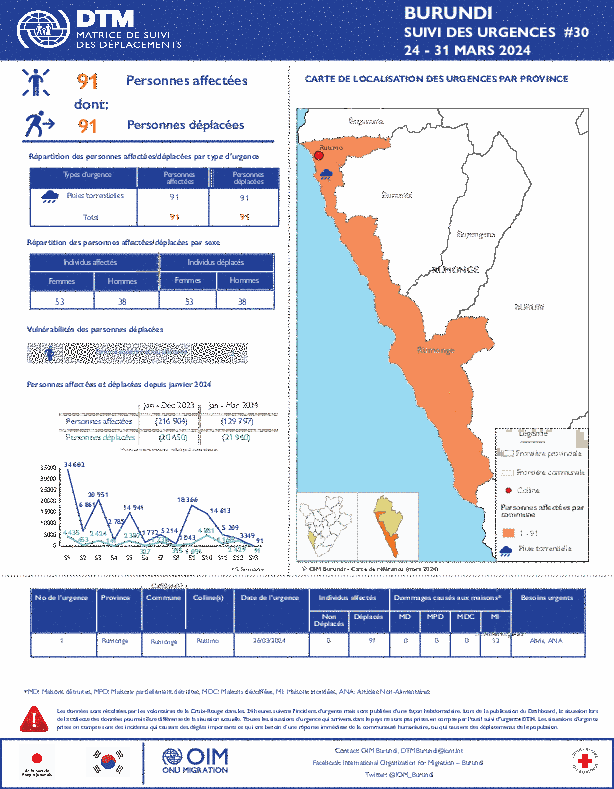-
Countries
-
Data and Analysis
-
Special Focus
-
Crisis Responses

Contact
DTM Nigeria, iomnigeriadtm@iom.int
Language
English
Location
Nigeria
Period Covered
Jan 01 2024
Jan 31 2024
Activity
- Flow Monitoring
This report presents the data for January 2024, collected through direct interviews and direct observation by DTM enumerators and triangulated via a network of key informants. It highlights the number of herders and their herds identified at 51 counting points. Notably, this enumeration included areas within the Kachia, Kaura, Kaita, and Faskari Local Government Areas (LGAs) of Kaduna and Katsina states, under the auspices of the UN Peacebuilding Fund. Additionally, it extended to Batsari, Jibia, Kankara, and Dansuma LGAs of Katsina state, which were supported by the European Union Fund.
In January 2024, Transhumance Flow Monitoring tool identified 3,548 herders in Kaduna State and 873 herders in Katsina State. The animal count was estimated at 72,011 for Kaduna State and 21,422 for Katsina State. Notably, 92 per cent of the total number of herders departed from states within Nigeria, while the remaining 8 per cent departed from Niger.
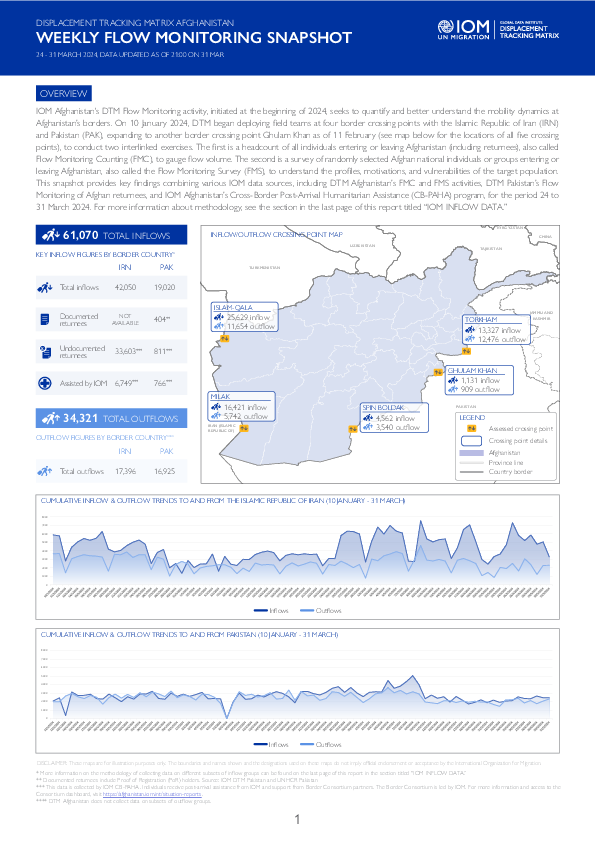
Contact
DTMAfghanistan@iom.int
Language
English
Location
Afghanistan
Period Covered
Mar 24 2024
Mar 31 2024
Activity
- Survey
- Flow Monitoring Survey
- Flow Monitoring
IOM Afghanistan's DTM Flow Monitoring activity, initiated at the beginning of 2024, seeks to quantify and better understand the mobility dynamics at Afghanistan’s borders. On 10 January 2024, DTM began deploying field teams at four border crossing points with the Islamic Republic of Iran (IRN) and Pakistan (PAK), expanding to another border crossing point Ghulam Khan as of 11 February (see map below for the locations of all five crossing points), to conduct two interlinked exercises. The first is a headcount of all individuals entering or leaving Afghanistan (including returnees), also called Flow Monitoring Counting (FMC), to gauge flow volume. The second is a survey of randomly selected Afghan national individuals or groups entering or leaving Afghanistan, also called the Flow Monitoring Survey (FMS), to understand the profiles, motivations, and vulnerabilities of the target population. This snapshot provides key findings combining various IOM data sources, including DTM Afghanistan’s FMC and FMS activities, DTM Pakistan’s Flow Monitoring of Afghan returnees, and IOM Afghanistan’s Cross-Border Post-Arrival Humanitarian Assistance (CB-PAHA) program, for the period 24 to 31 March 2024. For more information about methodology, see the section in the last page of this report titled “IOM INFLOW DATA.”
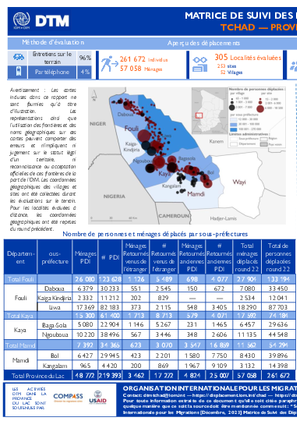
Contact
DTM Tchad, dtmtchad@iom.int
Language
French
Location
Chad
Period Covered
Dec 22 2023
Jan 24 2024
Activity
- Mobility Tracking
- Site Assessment
- Baseline Assessment
Depuis 2015, le Tchad fait l’objet d’attaques perpétrées par des groupes armés non-étatiques présents dans le bassin du Lac Tchad engendrant des déplacements massifs de populations, aussi bien internes que transfrontaliers. Au Tchad, l’OIM met en œuvre sa Matrice de suivi des déplacements (DTM, Displacement Tracking Matrix en anglais) dans la province du Lac depuis mai 2015 pour mesurer l’évolution du nombre, des profils et les besoins des populations déplacées à la suite de cette crise, afin de mieux orienter les programmes humanitaires et de développement. Les données sont collectées à travers des entretiens avec des informateurs clés (autorités locales, chefs traditionnels, représentants des personnes déplacées et gestionnaires de sites) dans les villages et sites d’accueil des personnes déplacées, ainsi que par des observations directes dans ces localités.
Ce tableau de bord présente les résultats des évaluations menées entre le 22 décembre 2023 et le 24 janvier 2024 dans 305 lieux de déplacement. Le Round 22 a enregistré une augmentation globale de 8 pour cent en termes de total de population déplacée par rapport au Round 21 dont 3 pour cent sur des sites existants, principalement dans les sous-préfectures de Liwa et Daboua, et 5 pour cent dus à des déplacements vers de nouveaux sites. Les principales raisons de l'augmentation de la population déplacée observée dans les lieux de déplacement évalués sont l'insécurité, qui se traduit principalement par des déplacements préventifs, les inondations de décembre 2023 et le retour de certaines personnes déplacées vers les zones d'agriculture et de pêche. La situation de déplacement dans la province du Lac reste volatile, avec la création de nouveaux sites de déplacement spontanés et l'abandon de certains sites existants. Cette collecte de données a été réalisée en partenariat avec la Commission Nationale d'Accueil et de Réinsertion des Réfugiés et Rapatriées (CNARR), le gouvernorat, l’Institut National de la Statistique, des Etudes Economiques et Démographiques (INSEED), le Ministère de l’Economie, du Plan et de la Coopération Internationale (MEPCI), le Comité Provincial d’Action (CPA) et l'Association pour l'Action Humanitaire et le Développement Durable (ACHDR). Les données ont été triangulées par la DTM et les acteurs humanitaires ont été impliqués dans l'analyse approfondie des données.
The Ukrainians and Third Country Nationals Crossing Back to Ukraine report presents findings from face-to-face interviews with individuals crossing back into Ukraine from five neighboring countries (Hungary, Poland, the Republic of Moldova, Romania, and Slovakia).
The findings in this report are based off on 27,653 surveys collected by DTM in 2023 and focuses in particular on the 6,086 surveys of adult individuals going to Ukraine during the fourth quarter of 2023 (October and December, Q4). Almost all (99%) of those who surveyed were Ukrainians, and a very small proportion (1%) were Third-Country Nationals (TCNs).
In Q4 of 2023, 31 per cent of Ukrainian respondents were prospective returnees (intended to stay in Ukraine), while 49 per cent planned to go for a short visit (short-time visitors). Another 20 per cent were unsure about the length of their visit.
The report delves into the socio-demographic profiles, reasons for return, duration of displacement, oblasts of origin and destination, needs and assistance, and experiences of discrimination of the surveyed individuals. The report also provides information on individuals who have already returned to Ukraine after a period of displacement abroad as well as those in Latvia who plan to transit through the Russian Federation to reach areas of non-government-controlled areas in Ukraine.

Contact
DTM Sudan; dtmsudan@iom.int
Language
English
Location
Sudan
Period Covered
Mar 21 2024
Mar 28 2024
Activity
- Mobility Tracking
- Baseline Assessment
Overview
On 15 April 2023, armed clashes erupted between the Sudanese Armed Forces (SAF) and the Rapid Support Forces (RSF) in multiple cities across Sudan. Clashes initially took place in cities across Northern and Khartoum states, later spreading across the Darfur and Kordofan regions.
Highlights
- DTM Sudan estimates that 6,622,565 individuals (1,320,273 households) were recently internally displaced.
- The IDP caseload was observed in 7,076 locations across all of Sudan’s 18 states.
- The highest proportions of IDPs were observed across South Darfur (11%), River Nile (11%), and East Darfur (10%).
- Field teams reported that the IDPs observed were originally displaced from twelve states. The majority (3,570,032 IDPs, 54%) were reportedly displaced from Khartoum state; followed by South Darfur (15%), Aj Jazirah (9%), North Darfur (9%), Central Darfur (4%), West Darfur (4%), South Kordofan (2%), East Darfur (1%), West Kordofan (1%), North Kordofan (1%), Sennar (1%) and White Nile (<1%).
- IOM-DTM also reported that an estimated 2,031,858 mixed cross-border movements were made into neighbouring countries.
- This product provides brief insights into those displaced in Sudan post-15 April 2023. For more granular information on the IDP caseload and the displacement context, please see IOM-DTM's Monthly Displacement Overview 07.
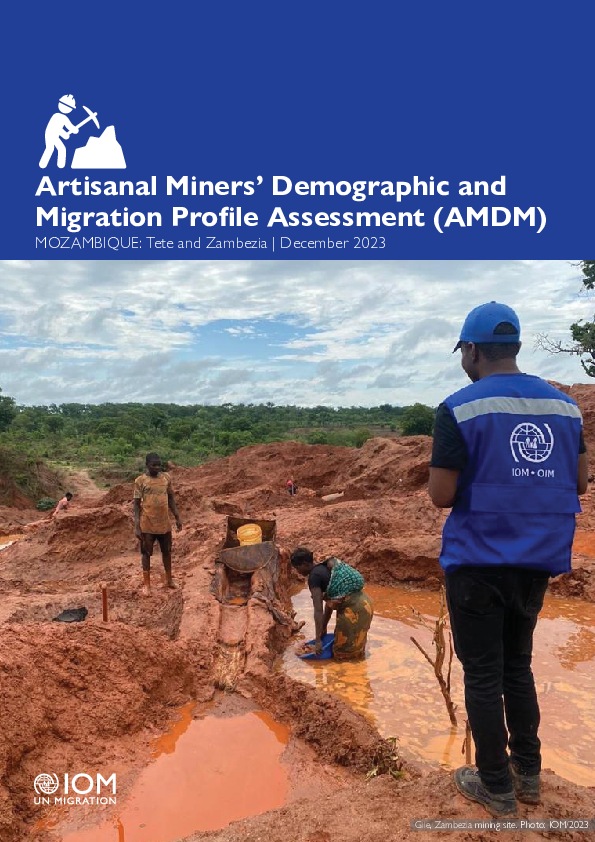
Contact
DTM Mozambique, DTMMozambique@iom.int
Language
English
Location
Mozambique
Period Covered
Nov 26 2023
Dec 02 2023
Activity
- Other
- Survey
Artisanal mineral extraction attracts high numbers of migrants within Mozambique, and the southern African region more widely. These informal mining points are particularly vulnerable to communicable diseases, and communities often have limited access to basic social infrastructure, including health facilities.
The Artisanal Miners' Demographic and Migration Profile Assessment (AMDM) aimed to explore the socio-economic and migratory patterns of artisanal miners in two significant locations: Gile, Zambezia, and Cahora Bassa, Tete. In focusing on these two remote mining areas in Zambezia and Tete respectively, the AMDM provides an evidence base that complements IOM's support to a migrant-friendly health service model that bridges gaps between migrants and host communities in vulnerable regions.
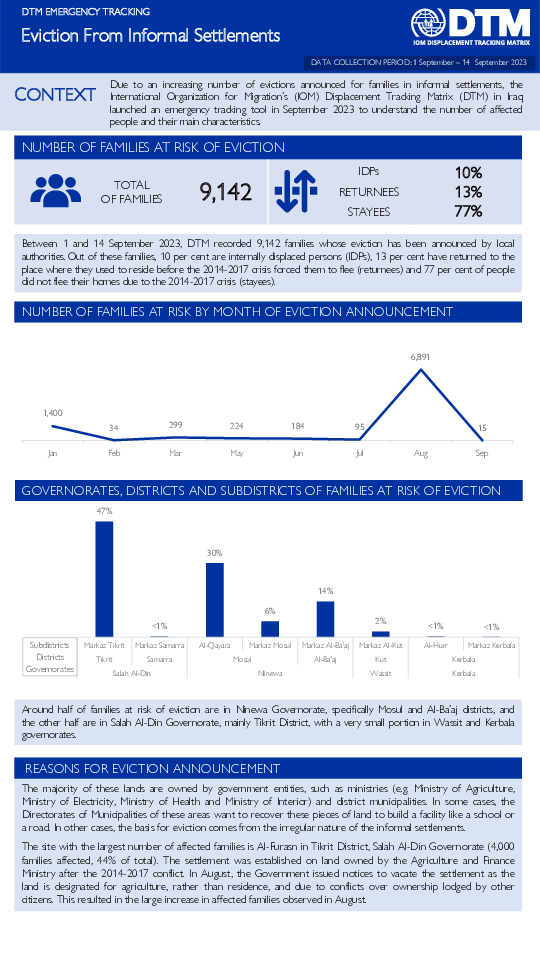
Contact
IraqDTM@iom.int
Language
English
Location
Iraq
Period Covered
Sep 01 2023
Sep 14 2023
Activity
- Mobility Tracking
- Event Tracking
Due to an increasing number of evictions announced for families in informal settlements, the International Organization for Migration’s (IOM) Displacement Tracking Matrix (DTM) in Iraq launched an emergency tracking tool in September 2023 to understand the number of affected people and their main characteristics.

Contact
IraqDTM@iom.int
Language
English
Location
Iraq
Period Covered
May 01 2023
Aug 01 2023
Activity
- Survey
With the end of the conflict with the Islamic State of Iraq and the Levant (ISIL), protracted displacement has come to characterize the post-conflict environment in Iraq. Around 1.14 million people remain internally displaced, nearly all of whom fled their areas of origin more than five years ago. In light of the above, it is essential to advance durable solutions to displacement in Iraq by improving living conditions to enable internally displaced persons (IDPs) to voluntarily take steps towards return, local integration or settlement in new locations. The Displacement Index (DI) is a tool designed to measure and monitor the living conditions of IDPs. Data collection for DI Round 7 took place between May and August 2023 across 18 governorates, 103 districts and 2,614 locations of Iraq. During this round, 24 fewer locations of displacement were assessed, compared to the previous round collected in January – April 2023, when 2,638 locations were assessed, as IDPs either returned to their areas of origin or moved to another location of displacement.
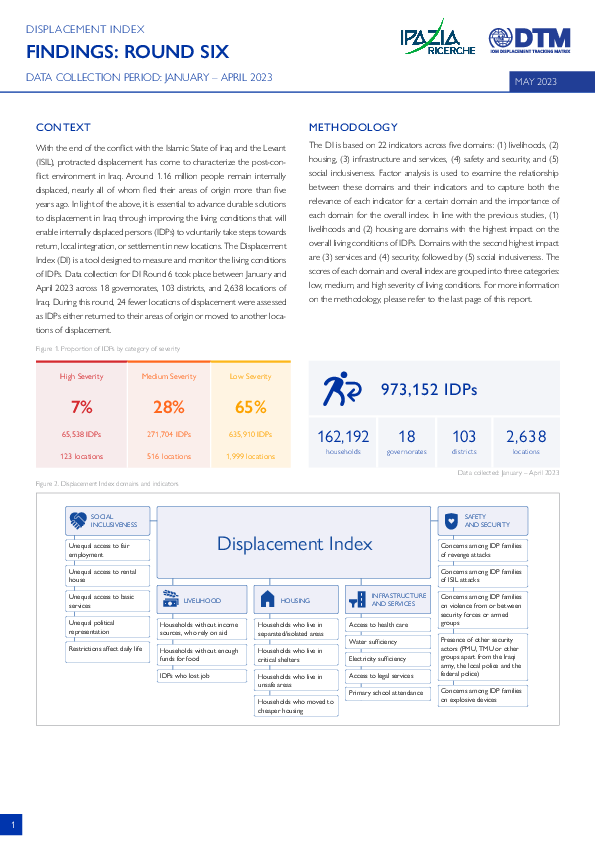
Contact
IraqDTM@iom.int
Language
English
Location
Iraq
Period Covered
Jan 01 2023
Apr 01 2023
Activity
- Survey
With the end of the conflict with the Islamic State of Iraq and the Levant (ISIL), protracted displacement has come to characterize the post-conflict environment in Iraq. Around 1.16 million people remain internally displaced, nearly all of whom fled their areas of origin more than five years ago. In light of the above, it is essential to advance durable solutions to displacement in Iraq through improving the living conditions that will enable internally displaced persons (IDPs) to voluntarily take steps towards return, local integration, or settlement in new locations. The Displacement Index (DI) is a tool designed to measure and monitor the living conditions of IDPs. Data collection for DI Round 6 took place between January and April 2023 across 18 governorates, 103 districts, and 2,638 locations of Iraq. During this round, 24 fewer locations of displacement were assessed as IDPs either returned to their areas of origin or moved to another locations of displacement.
